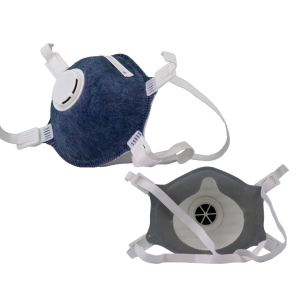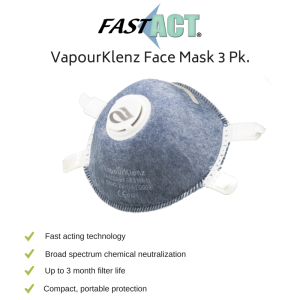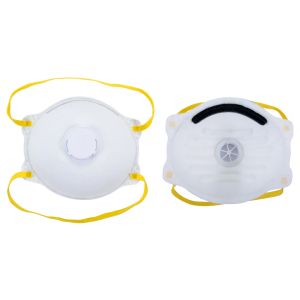When it comes to protection, prevention, and the minimization of spreading airborne germs, nothing quite works like a shielding face mask and/or respirator. More and more commonly people are wearing face masks when going out into a public space, such as airports, malls, parks, and even small confined spaces like airplanes, cars, and doctors’ offices/hospitals. People have become on high alert with the recent news of a pandemic virus being referred to as the Coronavirus, a virus that is easily spread from person to person. This virus originated in Wuhan, China where more than 1,100 people have died from this virus and more than 45,500 people have been sickened by this virus. This pandemic illness has led to the increase use in face masks – both surgical face masks and respirators to help protect people from airborne illnesses such as the Coronavirus and other viruses that may be present in the airspace of your environment.
Surgical face masks and respirators are two types of face masks that many people are turning to as a form of respiratory protection when they go into a known toxic environment. However, these two forms of respiratory protection will both work in different ways and contain different capabilities when it comes to filtering out airborne pollutants in the air. Which is better to use a surgical face mask or FFP3 respirator, and in what instances should you wear either of these protective face masks?
In this article we are going to learn more about the differences between surgical face masks and FFP3 respirators and determine when an individual should wear a surgical face mask vs when they should wear a FFP3 respirator in the environment.
What is FFP Mask
 When it comes to intruders that may be found in the air space of an environment, this can include chemicals, odors, and particulate matters (like allergens, viruses, bacteria, and even mold). The use of surgical masks and/or respirators is one of the many practices used today to try to reduce exposure and risks of infectious disease transmission through airborne pollutants – as this is among the most popular method of infection for individuals. Surgical masks are the most prevalently used type of face mask due to its easy purchase, small price tag, and effective nature, however, when it comes to removing those finer particulate matters from the air that viruses and bacteria are usually present in, do these masks really work at shielding a person’s respiratory system?
When it comes to intruders that may be found in the air space of an environment, this can include chemicals, odors, and particulate matters (like allergens, viruses, bacteria, and even mold). The use of surgical masks and/or respirators is one of the many practices used today to try to reduce exposure and risks of infectious disease transmission through airborne pollutants – as this is among the most popular method of infection for individuals. Surgical masks are the most prevalently used type of face mask due to its easy purchase, small price tag, and effective nature, however, when it comes to removing those finer particulate matters from the air that viruses and bacteria are usually present in, do these masks really work at shielding a person’s respiratory system?
Dust masks, aka surgical masks, will come in a variety of different types of classifications that will all filter certain pollutants from the air and have different overall capabilities in protecting a person’s respiratory system. If you have ever used a face mask you may have seen the code FFP labeled on them, what does is an FFP mask? FFP stands for “filtering facepiece” and this type of face mask is classified as either FFP1, FFP2, or FFP3, which indicates what and how many particles of suspended dust, mist, or fibers are filtered.
FFP1 FFP2 FFP3
The three classifications of FFP masks; FFP1, FFP2, and FFP3 all contain different capabilities and will work to filter certain pollutants in the air. When it comes to the three classifications of FFP masks the rule of thumb is the higher the number, the better the protection – meaning a FFP3 will offer an individual the most protection out of the three FFP masks. According to a research article conducted in 2015 called Particle Size-Selective Assessment of Protection of European Standard FFP Respirator and Surgical Masks Against Particles-Tested with Human Subjects, they found that protection factors of FFP respirators were 11.5 to 15.9 times greater than those of surgical masks.
Below we are going to learn more about the differences between FFP1, FFP2, and FFP3 face masks and how they work to protect an individual’s respiratory system.
![FFP1 FFP2 FFP3]() FFP1: The FFP1 classification respirator masks were designed for working environments where there are no poisonous or fibrogenic dust particles or aerosols expected in the air. FFP1 masks will filter at least 80% of the particles that measure up to 0.6 microns in size. This type of respirator mask is commonly worn in the building or food industry.
FFP1: The FFP1 classification respirator masks were designed for working environments where there are no poisonous or fibrogenic dust particles or aerosols expected in the air. FFP1 masks will filter at least 80% of the particles that measure up to 0.6 microns in size. This type of respirator mask is commonly worn in the building or food industry.- FFP2: The FFP2 classification respirator mask protects from firm and fluid harmful kinds of dust, smoke, and aerosols. These types of respirators must contain at least 94% of the particles measuring up to 0.6 microns. FFP2 respirators are often worn in the metal and mining industry, or in environments where you will come into contact with aerosols, fog, and smoke in the air. The total leakage of this face mask is a maximum of 11%.
- FFP3: The FFP3 classification respirator mask protects poisonous and volatile kinds of dust, smoke, and aerosols from the air space. When you are working with or near pathogens in the air like viruses, bacteria, and fungal spores, the FFP3 class respirator masks are recommended. The total leakage of these masks is a maximum of 5% and they must filter 99% of all particles measuring up to 0.6 microns. Additionally, these classification of FFP masks also filter poisonous, oncogenic, and radioactive particles.
FFP3 Mask vs N95
A popular type of respiratory mask that is commonly worn and purchased is that of a N95 mask. N95 masks are disposal masks that are certified by the National Institute for Occupational Safety and Health (NIOSH). This type of respiratory mask filters at least 95% of airborne particles but it is not resistant to oil, this is due to air purifying respirators such as filtering facepiece respirators and chemical protective cartridges that have integrated particulate filter elements. According to the United Stated Centers for Disease Control and Prevention (CDC), they recommend the use of NIOSH certified respirators equivalent to N95 or greater to prevent the inhalation of infectious particles like viruses, bacteria, and other airborne pathogens.
Whereas a FFP3 mask protects against higher levels of dust, while also protecting against solid or liquid aerosols. This type of disposable face mask is said to provide the highest level of protection that a disposable mask can offer to an individual. Specifically, a well-fitted FFP3 mask will protect against fine toxic particulates including asbestos, bacteria, viruses, and radioactive particles.
Dust Mask vs Respirator
Comparing the differences between a dust mask and a respirator is important to highlighting the capabilities of each type of mask when it comes to specific pollutant removal in the air. Dust masks are a non-NIOSH approved mask that is a cheaper disposal face mask for mitigating pollutants from the air. These types of masks can be worn during non-toxic activities or environments that do not contain or create dusts, vapors, and gases into the air space. Generally, these dust masks are designed to stop liquid droplets or aerosols from coming out of the wearer’s mouth, rather than filtering the air that is coming into the mouth. These dust masks do not contain filters and no facial seal, which will all for particles to easily enter into the respiratory system of an individual – making this type of mask ineffective against particulate matter inhalation.
 A respirator mask, on the other hand, is a type of face mask that contains a tight facial seal, as most of them contain two sets of straps that will be adjusted to create that tight seal to the face that you will want when minimizing exposure to airborne pollutants. When a respirator mask is worn effectively, these masks will be capable of filtering out the small respirable particles found in the environment that may have been produced by wildfires and other events that will lead to higher concentrations of pollutants in the air. Typically, however, these respirators will not filter out fumes and gases from the air, like other face masks will when used in the environment.
A respirator mask, on the other hand, is a type of face mask that contains a tight facial seal, as most of them contain two sets of straps that will be adjusted to create that tight seal to the face that you will want when minimizing exposure to airborne pollutants. When a respirator mask is worn effectively, these masks will be capable of filtering out the small respirable particles found in the environment that may have been produced by wildfires and other events that will lead to higher concentrations of pollutants in the air. Typically, however, these respirators will not filter out fumes and gases from the air, like other face masks will when used in the environment.
How Long Can You Wear A Surgical Mask
When it comes to wearing a surgical mask the duration of time that these masks will be effective is important to understand and abide by to help prevent risks from occurring to an individual and their health. As we have discussed previously, surgical masks are designed to help the spreading of fluids or aerosols from coming out of the individual who is wearing this mask. When this begins to happen, it will create moisture in the surgical mask that will exacerbate the likelihood of infections and debris collection in the air, and even worse it will just make the surgical mask downright uncomfortable on your face. Therefore, it is recommended that you only wear your surgical mask for up to 8 hours at a time and replacing the mask after reaching this recommended usage time.
How Long Can You Wear A FFP3 Mask
FFP3 masks are categorized as disposal masks that will offer a level of protection from nuisance particles, gaseous compounds, and vapors in the air, all through the use of an integrated filtration technology used within this mask. These masks will be an effective solution to filtering out certain pollutants from the air and thus when the user wears a FFP3 mask it will potentially make it more challenging for the wearer to breathe through this mask for a long period of time. It is usually suggested that when wearing a FFP3 mask that the wear time of this mask does not exceed more than 60 minutes at a time without a break. However, just because a user shouldn’t wear this mask continually for more than 60 minutes does not mean that it is ineffective after each use. Typically, these masks will have a user life of about 3 months, depending on the conditions in the environment and the amount of use the masks gets from the wearer.
When to Use a Mask Respirator
When it comes to wearing a mask respirator there can be several cases or instances in which it will be important to arm yourself with this protective gear to minimize the exposure to airborne pollutants within the environment. We have discussed the differences between a surgical mask and that of a FFP3 respirator, however, we haven’t discussed when is the appropriate time to wear either of these masks – such as in a hospital, during a wildfire, or even to shield oneself from bacteria or viruses in the environment.
Below we are going to discuss when to use a mask respirator like the FFP3 or when to use a surgical mask, depending on the situation and the environmental conditions.
 When to Use a Surgical Face Mask
When to Use a Surgical Face Mask
- Wear a surgical face mask in a cohorted area such as cleaning a room, cleaning equipment, discharging patient rooms, etc.
- Close contact with patients such as providing them with patient care, direct home care visits, diagnostic imaging, phlebotomy services, etc.
When to Use a Respirator FFP3 Mask
- Carrying out potentially infectious aerosol generating procedures
- When a patient is known/suspected to have an infection spread via the aerosol route
- When caring for patients known/suspected to be infected with a newly identified infectious respiratory virus
Where to Buy FFP3 Respirator Mask
 If you have ever looked for a FFP3 respirator mask, you may have gone to your local hardware store to stock yourself with these respirator masks. These hardware stores will have an array of face masks and respirators for Consumers to choose from, and these masks will include surgical masks, dust masks, and masks that bear different classifications such as FFP1, FFP2, and FFP3. However, when it comes to purchasing a high-quality FFP3 respirator mask the best place to buy this type of mask is on FAST-ACT’s website.
If you have ever looked for a FFP3 respirator mask, you may have gone to your local hardware store to stock yourself with these respirator masks. These hardware stores will have an array of face masks and respirators for Consumers to choose from, and these masks will include surgical masks, dust masks, and masks that bear different classifications such as FFP1, FFP2, and FFP3. However, when it comes to purchasing a high-quality FFP3 respirator mask the best place to buy this type of mask is on FAST-ACT’s website.
The FAST-ACT VapourKlenz Face Mask FFP3 Respirator contains the proprietary FAST-ACT® technology that offers chemical neutralization from nuisance particulates and chemical odors. The metal oxides of the FAST-ACT technology allow for a variety of chemical pathways to interact and break down the various toxic and noxious compounds, therefore providing defense against vapor releases and attacks, toxic and noxious chemical malodors, and respiratory protection.
The post When to Use a Surgical Face Mask or FFP3 Respirator appeared first on Fast Act.
 FFP1: The FFP1 classification respirator masks were designed for working environments where there are no poisonous or fibrogenic dust particles or aerosols expected in the air. FFP1 masks will filter at least 80% of the particles that measure up to 0.6 microns in size. This type of respirator mask is commonly worn in the building or food industry.
FFP1: The FFP1 classification respirator masks were designed for working environments where there are no poisonous or fibrogenic dust particles or aerosols expected in the air. FFP1 masks will filter at least 80% of the particles that measure up to 0.6 microns in size. This type of respirator mask is commonly worn in the building or food industry.